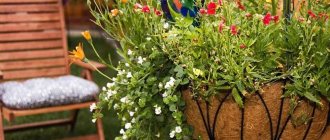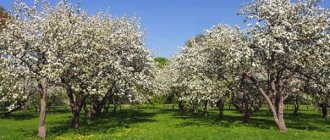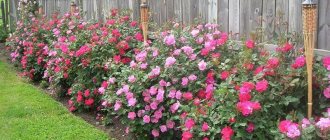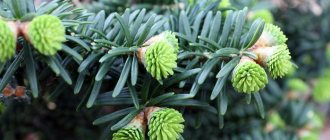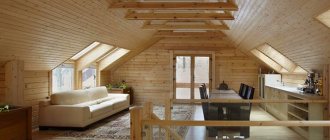It’s rare that a summer cottage, and even more so a garden, does without flower beds. Flowers give us considerable aesthetic pleasure; they delight us with their presence and, attracting our eyes, make us admire them. That is why flowers are permanent residents of garden plots. And they are grown, as a rule, not chaotically, but in flower beds, in beautifully decorated flower beds. At the same time, they are selected according to color, crop varieties and many other factors. And to make flower beds from annuals, the diagrams of which you will find in the article, yourself, you do not need to have the skills of a landscape designer. The main thing is that everything is correct
Rules for creating flower beds
Before you start creating a flower garden on your site, you should familiarize yourself with the basic rules for carrying out the work. They will make it easier to understand the process of arranging flower beds and will allow you to do them not only quickly, but also in the best possible way.
- Never rush. This rule is especially relevant for newcomers to the world of gardening who recently bought a cottage or garden. The fact is that in one season you are unlikely to have time to qualitatively and beautifully arrange all the planned territories. It is best to tackle the most important problems at the beginning of developing a dacha plot and at the same time equip a small, modest flowerbed. Over time, you will be able to cover other areas and plant them with flowers selected according to the color scheme and characteristics of the growing season.
Design of a flower bed of annual flowers
- Before you go to the store for seeds, think about what you want your flower garden to look like. Remember that only a flowerbed that meets all your wishes can become a source of pride, which should first be reflected on paper in the form of a diagram.
- In accordance with the scheme and climatic conditions, select annual flowers that will perfectly match in color and requirements for growing conditions. But beginners should not immediately get involved with capricious cultures. It’s better to start by practicing creating flower beds from unpretentious varieties.
- Remember that the foundation of a flower bed is the plants that cover the soil. They will cover not only the brown soil, but also the stems of taller flowers. In addition, they are excellent soil protectors from moisture evaporation and growing weeds.
- You shouldn’t plant plants one at a time – they always look much better in groups. But too many crops are bad, as it will be inconvenient for them to grow.
- When drawing up a diagram, remember that any flower garden should have its own zest. This could be some kind of central decorative bush, beautifully arranged perennials, annuals that are somehow different from the bulk of the flowers surrounding them and stand out against their background.
Flower garden schemes
Raised bed of petunias and lobelias
Flowerbeds of annuals photo
On a note! Despite the fact that many gardeners choose perennial crops to create flower beds, annuals also do not go out of fashion. They are often unpretentious, easy to grow, and allow you to create completely new and unique compositions every year. In addition, they are very beautiful and bloom with rich, bright flowers, which is their main advantage.
Beautiful flower bed with petunias
Herbs
Perennial grasses
Sedge Morrow Variegata
Ophiopogon flat-arrowed
foxtail pinnately
Hakonechloa
Gray fescue
Imperata
Rules for choosing planting material and location
One of the first tasks of a gardener when arranging a flower bed is choosing its location. The flowering period will largely depend on this. The place where the flower bed is located should be well lit. It is also worth thinking about the convenience of watering - flowers need regular supplies of water. You should not place the flowerbed behind the house away from a barrel of water or an irrigation system. It makes no sense to plant a flowerbed where no one will see it - flowers were created by nature in order to admire them. So let the flowerbed be in a visible place - at the exit from the house or outside the window, at the entrance to the house.
Flowers should be placed in a visible place
A few more words about the choice of planting material. Be sure to consider color, flowering period, and height. Any flower bed should bloom for as long as possible, and the correct selection of flowers according to their flowering time will help prolong the flower beauty - that is, when the flowering period of some ends, others will replace them.
Number seven 7 made from flowers
Flower beds can be different in shape and height. And each type has its own unwritten design rules. For example, when creating three-tiered flower beds, the tallest plants should be located in the center or in the background. Along the edges there will be lower crops, which will act as a kind of frame. Between these two tiers there will be a second one, which sets the main background for the flower garden.
Amaranth, fragrant tobacco or other plants that bloom all summer are planted in the center of the flower beds.
The number of flowers is calculated approximately like this: central flowers - several pieces or a small patch of fairly tall plants. Crops with an average height are planted in quantities twice as large as the main ones. And the shortest ones will have a population three times greater than that of the main flowers.
DIY mill for the garden
The main function of such a structure is, of course, decorative - a mill on the site pleases the eye and creates an atmosphere of comfort. It is also used to decorate gardens and flower beds in the Old Russian or European style (depending on the appearance of the object itself). Read this article for more details.
It is best not to take more than 3 types of flowers and not create complex compositions when arranging your first flowerbed. In this case, care will be simple and pleasant.
Making a flower bed
Duchesnay
This unusual plant is often confused with... strawberries. It really resembles it both in leaves and “fruits”. This is what people call it: “false strawberry.”
The flowering period is short, the flowers themselves are yellow and inconspicuous, but they look beautiful against the background of a green carpet. By the way, this carpet does not lose its attractiveness all summer long; it spreads across the dacha area, but does not weave everything in a row. The berries that form after flowering are not poisonous, but tasteless, so throughout the summer season they serve only a decorative function. Duchesnea looks “like a cucumber” in the sun, even with extremely rare watering. So this is a great option for those who rarely visit their country house.
Photo: Instagram maman.vs
Photo: Instagram photo_trip_sochi
Photo: Instagram filifionka_annet
- Landscape
How to make a flowerbed that does not require complex care: 5 practical tips
Types of flower beds
Flowerbeds can have completely different shapes and sizes - it all depends on your wishes and capabilities. They are round and square, figured, triangular.
Flowerbed shapes
There are three main ways to form flower beds.
- Uniform carpet . Typically, this type uses plants of only one species or similar in size but with different petal colors. Such a flowerbed is easy to care for, and it looks very impressive.
- Multi-tiered flower bed . It is created by combining flowers of different heights, but the lowest crops will always be in front. It can be round, corner, wall. Such plantings are more difficult to maintain.
- Flower borders . These are flower beds created along garden paths. They are unpretentious and are usually created from one or two types of plants.
Blooming paradise in your favorite garden
There are also very unusual flower beds that can complement any elements of a summer cottage - for example, decorate the area around a pond, or have the shape of an animal.
An example of an original flowerbed in the shape of a pig
Lavender
An unpretentious evergreen ornamental shrub, popular not only for its blue or purple spike-shaped flowers, but also for its persistent, refined aroma. When planted in groups, the effect of a continuous “blanket” is obtained, for which this plant is especially favored by lovers of atmospheric photos. Some varieties bloom from early summer to autumn, while others bloom from April to July, and then produce a second wave of flowering in September.
Seeds Gavrish Medicinal series Lavender Voznesenskaya
An open area is optimal for lavender, and watering in hot weather is about twice a week.
Photo: Instagram _sleepy_apple_
Photo: Instagram lrinakachanova
Photo: Instagram pinacolada_garden
- Landscape
7 most beautiful climbing flowers for the garden
Choosing colors
An important aspect when drawing up a flower bed scheme is the color of plant buds. At the initial stage, it is better to use only 2-3 contrasting shades, and later move on to more complex color transitions and combinations. But even a beginner should understand that color has a significant impact on a person’s psycho-emotional state, so you should choose plants that produce flowers with the shade of petals that you like.
Choosing colors for a garden flowerbed
Table. Colors and their influence on humans.
| Color | Characteristic |
| Yellow | It is usually preferred by joyful and active people; it is the color of a good mood. And it will give confidence to a shy person. In the garden, this color will be given by lilies, marigolds, calendula, snapdragons, daylilies, cinquefoil, and rudebeckia. |
| Pink | Improves mood, relieves sad thoughts. Meadowsweet, cosmos, petunia, carnation, daisy will give this color in the flowerbed. |
| Blue | Calms, comforts, relieves stress. Iris, lavender, forget-me-not, delphinium - flowers with blue petals. |
| Red | The color of energy, strength, optimism, passion. Carnation, primrose, rhododendron will give it to you. |
| Violet | A color that improves your emotional state and has a positive effect on the functioning of the immune system. These are lilacs, violets, speedwell, pansies, and aster. |
| Orange | A color that gives self-confidence and lifts your spirits. These are chrysanthemum, marigolds, cinquefoil, and gravilate. |
Flowerbed of petunias and marigolds
Yellow flowers for a flower bed
On a note! Variegated flower beds can always be slightly diluted with white flowers. They will add zest to the plantings. And in order to choose colors that combine with each other, use the color wheel.
Marigold
Also known under the Ukrainian name “chornobryvtsi”. They came to us from America, and now it’s hard to imagine a Russian dacha without them. And all because this is perhaps the easiest plant to care for, even for a beginner. By the way, they are easy to grow from scratch. You can start the sowing campaign in early spring, but it is better to do it indoors. At the end of April - beginning of May, marigolds are no longer afraid of open ground. But if there is a threat of frost, it is better to cover them with film.
In the open sun, marigolds bloom most magnificently. But, as with petunias, if it is not possible to water frequently, it is better to choose partial shade. They bloom until autumn and then “die”. But you can collect the seeds and grow them next year.
Photo: Instagram vovchik_dik
Photo: Instagram anna1_knyazeva
- Landscape
10 best garden shrubs that bloom with white flowers
Selection of types of flowers
Creating a beautiful flower bed is a creative process that can completely absorb any gardener. This is a great way to realize your potential as a creator. By choosing the right plants for your flower beds, you can create a real living work of art on your site.
Making a flower garden from annuals
Scheme of a triangular flower bed
A huge number of seeds of all kinds of flowering plants are now sold on store shelves. Which ones are best suited for creating flower beds? First of all, focus on the growth and flowering period of plants, as well as the color of their petals.
Table. The most popular types of flower plants for flower beds .
| Name | Flowering period | Height, cm |
| Lobelia | June-September | About 15 |
| Ageratum | July-October | 15-70 |
| Iberis | June-October | Up to 40 |
| Marigold | June-September | 15-100 |
| Nasturtium | June-October | Creeping up to 400, bush 50 |
| Petunia | June-mid October | 15-80 |
| Zinnia | June-October | 20-70 |
Also, low-growing annuals include: dwarf begonia, viola, lobularia, dwarf aster; for tall ones: lupine, peony, astilbe.
raised flower bed
Prices for annual seeds
annual seeds
Purslane
And this plant lives without shade or watering in the heat for as long as desired. Even the popular name “midday heat” speaks about this remarkable quality. Small bright flowers open their petals at ten o'clock in the morning and close at dusk. It spreads beautifully like a carpet over the lawn and is also suitable for hanging flowerpots.
Photo: Instagram my_own_paradise4142
Photo: Instagram guslica
Photo: Instagram _ania_b_
Photo: Instagram zarema_151008
- Landscape
9 garden plants that will make your 5 acres visually larger
Flower schemes
To make it easier to navigate when creating your own scheme, we suggest that you familiarize yourself with several simple but beautiful ready-made options.
Table. Flower bed schemes.
| Scheme, photo | Description |
Scheme No. 1 | 1 – annual stock roses of three colors (white, red, yellow); 2 – decorative sunflower; 3 – Spanish poppy; 5 – cardinal lobelia; 6, 7, 8 – bell, catnip; 10 – sedum. The remaining flowers can be selected in accordance with the color indicated in the diagram. |
Scheme No. 2 | Flowerbed cake: 1 – low red flowers; 2 – white or silver flowers; 3 – medium-sized plants with red flowers; 4 and 5 – high background crops. |
Scheme No. 3 | Round flowerbed: 1 – cannas; 2 – begonia; 3 – petunia; 4 – snapdragon; 5 – marigolds; 6 – alyssum; 7 – ageratum; 8 – pyrethrum. |
Scheme No. 4 | 1 – amaranth; 2 – zinnia; 3 – garden quinoa; 4 – chard; 5 – basil; 6 – nasturtium. |
Scheme of a flower bed of shade-tolerant annuals
Planting flowers by sector
Scheme of a round flower bed of tulips, daffodils, hyacinths, scilla and mouse hyacinth
Flowerbed of bulbous plants - diagram
Calendula
For many, this is a country must-have, just like marigolds and petunias. And not only due to its medicinal properties. Its decorative component is also excellent.
If you sow calendula in the ground in late autumn, it will withstand frosts down to minus 5°C, and in the spring it will bloom very early. Then it will reproduce on its own in the sunniest places; it only needs to be thinned out and planted. You don’t have to bother with frequent watering - calendula tolerates a long absence of moisture well.
Photo: Instagram victoriaorlova_
- Landscape
16 plants that can still be planted in August at the dacha
We create a flower garden with our own hands
Let's look at the creation of a flower bed step by step using the example of such a wonderful flowering corner.
DIY flowerbed
Step 1. Create an exact diagram of the future flower garden in accordance with your capabilities and wishes. Don’t just try to design large flower beds - it’s better to make one small and neat than a large one that you won’t have enough strength for. The best option to start with is a flower bed with 25-30 plants.
Step 2. Choose a sunny place on your summer cottage. Step back about 1 m from the fence. To prevent the sun from damaging the plants, place the flower bed on the eastern side of the fence or buildings. Mark the border of the flower bed.
Choosing a suitable location on the site
Step 3. Remove all debris from the site, dig up the soil, and apply fertilizer if necessary. Weed out all the weeds.
Digging the soil
Step 4. Level the surface of the soil, break up the earthen clods.
Leveling the soil
Step 5. Purchase flower seedlings or use ones you grew. Plant tall crops in the far corner, then medium-sized crops, and place low-growing crops along the edge of the flowerbed. In this case, holes for all flowers can be dug in advance.
Planting flower seedlings
On a note! Be sure to consider the size of an adult plant when planting. It is important that over time the flowers do not press on each other, but there are no large gaps between them.
Step 6. Take good care of the flowerbed - regularly water the flowers, remove wilted ones, fertilize.
Watering flowers
This way you can arrange a corner flowerbed on your site. With a round one you will have to work harder. The fact is that its edges must form a perfectly smooth circle, otherwise it will appear crooked. But achieving an excellent result is quite simple: a stick is dug into the center of the flower bed, and a rope equal to the radius of the flower bed is tied to it. Moving the rope in a circle, outline the boundaries of the flowerbed with sand. And so that the plants “fall” into place, you can make a preliminary sketch inside the circle with sand, outlining where the holes for each flower will be marked.
Begonia everblooming in a flowerbed
Gardeners whose plots do not allow them to set up a whole garden can get out of the situation by creating flower borders along the edges of the paths. They look very beautiful, especially if they are made from flowers of the same type.
Workbed of several types of plants
Work in landscape design
And finally, some tips for arranging flower beds.
- Do not forget to leave gaps of about 10-15 cm between plants planted in the ground. This is necessary for optimal development of crops.
- Do not place the flower garden in a low area, especially if it rains often in your region. Otherwise, the soil under the flowerbed will be too damp and the flowers will begin to hurt.
Scheme for creating a round flower bed
Gravel garden - well-groomed flower beds without constant worries
Do-it-yourself vertical flower beds - a magnificent decoration for a summer house
Creating a flower garden with your own hands, following the diagram, is not so difficult, and you have seen this personally. The main thing is not to rush and think through everything carefully, then planting will definitely go like clockwork, and you will enjoy the beautiful flower beds in your garden all summer.
Video - Continuous flowering beds of annuals
Annuals
To the delight of flower growers, the list of low-growing flowers for flower beds that bloom all summer is quite large and is constantly updated with new varieties, which are bred by foreign and domestic breeders. Moreover, within one plant genus there are often a number of varieties. For example, petunia, which has ampelous, spreading bush and dwarf forms. Or universal participants in various plantings in the garden - marigolds, divided into erect, deviated, thin-leaved.
Ageratum
Ageratum Mexicana is also known as “long-flowered,” which is explained by its ability to bloom from June until the coldest weather . Forms straight, branched, strong bushes covered with colorless hairs. The leaves are arranged oppositely. Blue, white, blue, lilac and pink narrow-tubular flowers are collected in an inflorescence-basket, up to 1.5 cm in diameter. Several baskets make up a shield.
Ageratum is planted along paths in the garden, in flower beds, alpine hills, dwarf forms are suitable for container growing
Alyssum
Sea alyssum (mason, alyssum) belongs to the Brassica family. This small (5-20 cm) herbaceous plant with almost recumbent stems and narrow leaves forms lush flowering bushes. Caps of small, fragrant honey flowers of white varieties resemble clouds. Blooms from June until frost . It is not difficult to grow seedlings, especially since the seedlings are not as thin as those of lobelia, and are planted later - in early April. Seeds can be sown directly in open ground at the end of April or before winter.
Alyssum is a mountain plant, so it prefers open sunny areas, ideal for rocky gardens, borders, hanging baskets, flowerpots
Marigolds (tagetes)
These sunny, unpretentious, fast-growing flowers have been popular in our country for several decades. Growing them is a pleasure - those sown in April through seedlings sprout quickly and amicably. They will also grow well in a greenhouse or open ground. They love sunny places, but also tolerate partial shade. They bloom from June to October . For the first plan of a flower bed, creating spots of color, flowerpots, boxes, you can choose low-growing varieties of terry and simple shapes. Marigolds come to the rescue when you need to fill empty spaces.
Thin-leaved marigolds go well with blue lobelia (photo by the author)
Begonia everblooming
A popular participant in urban decorative landscaping, it turns out that it has been loved by flower growers since the 19th century for its constant flowering and ease of care. The plant can be used not only as a seasonal flower bed, but also as an indoor one. They usually plant seeds for seedlings, starting in February (additional lighting is needed). If you only need a few bushes to create a small composition, it’s easier to buy them in flower shops in the spring.
The most common varieties are those with white, pink and red petals.
Verbena
Compact forms of verbena reach only 20-30 cm in height. The plant is pubescent. The leaves are serrated and oblong. The flowers are regular, sessile, varied in color, collected in an inflorescence - a corymb. Blooms from June to October. Seedlings are sown in March.
To get a bright flower bed, you can plant one variety or a multi-colored mixture
Lobelia
An undoubted decoration of the garden, verandas, and balconies is lobelia. Among the low-growing varieties with a height of 15-30 cm, it is worth highlighting: “Purple Palace”, “White Palace”, “Pink Riviera”, “White Riviera”, “Regatta Sky Blue”, “Beauty of Russia” (mixture). The two-color options are especially beautiful - with a white eye.
Lobelia seeds are very small; they are sown for seedlings in February, scattered over the surface of the soil, covered with glass or film until germination. The most difficult care is when the seedlings are small: careful, timely watering is needed. From a strong stream or overflow, seedlings can fall down and die. You need to plant 3-4 plants in separate cups for better stability and survival rate. So, in groups, and subsequently planted in open ground.
Lobelia, like alyssum, blooms from June to late autumn. The photo was taken on November 1, 2021 in the Tver region (photo by the author)
Snapdragon
Snapdragon (antirrhinum) belongs to the Norichinaceae family, and its origin comes from the Mediterranean. It has highly branched, densely leafy stems. Blooms 60-80 days after germination. Flowering is abundant and long - from early summer to late autumn . The flowers range in color from pure white to dark purple, in a variety of shades and combinations. Collected in spike-shaped inflorescences.
More than 800 varieties are known. Among the short ones, the following have proven themselves well: “Schneeflocke”, “Snapshot Burgudni”, “Kimono greenish-yellow”, “Kimono apple blossom”, mixtures “Round Dance”, “Magic Carpet”, “Bright Kimono”.
Antirrinum is grown in seedlings and without seedlings, used to decorate flower beds, balconies, loggias
Nemesia goiter
Nemesia also belongs to the Norichnikov family; the plant’s homeland is Africa. Flower growers appreciated it for its variety of colors, abundance, and decorative flowering. Nemesia is good in single plantings, in flower beds, hanging baskets, and pots. Seeds are sown for seedlings in March - early April, in the south they are sown directly into the ground.
The variety of colors of nemesia is amazing; there is a similarity with snapdragons, pansies, and white and blue varieties vaguely resemble lobelia
For better tillering of lobelia, alyssum, and nemesia, the tops of seedlings should be pinched.
Low growing nasturtium
Southern nasturtium loves warmth, light, and does not tolerate drought. It is recognizable by its long, climbing stems, beautiful rounded leaves, large flowers with a distinctive aroma and special, large, ribbed seeds that can be pickled like capers. But among the climbing forms there are also compact, low-growing ones: “King Theodore”, “Day and Night”, “Mahogany”, “Golden Ball”, “Baby Salmon”.
Nasturtium "Alaska" is notable for its variegated foliage
Petunia
Speaking about low-growing annual flowers for flower beds, one cannot ignore the “star” of flower beds and balconies - petunia, which belongs to the Solanaceae family. The range of hybrids is extremely large. For open ground, it is recommended to choose compact, spherical, low-growing forms with simple colors: “Cherry Crystal”, “Chirosis blue and white”, “Pikoti”; terry: “Duo Salmon”, “Duo Burgundy”, “Tarte Bonanza”.
Multi-tiered flower bed of different varieties of petunias with a simple corolla shape
Cellosia
A representative of the Amaranthaceae family, it belongs to the group of dried flowers - it is perfectly preserved when cut and is used to create winter bouquets. There are three forms: pinnate, comb, spikelet. Blooms from July to October .
Cellosia pinnate in the foreground of the garden path border, in the background are marigolds
Zinnia
It is an erect plant with a fairly powerful, strong stem. Low-growing varieties are distinguished by a spherical, compact bush shape. The inflorescences have a diameter of 5-6 cm, the densely double ones are especially beautiful. They bloom from June to autumn . Growing from seeds is not difficult because the seeds are large. They are planted as seedlings in April or sown in open ground in May.
Particularly interesting are two-color hybrids, for example, “Swizzle Cherry Ivory” (pictured)
Additional information about the different types of annuals used to decorate flower beds can be found in the article on our website.
Daylilies
These luxurious flowers were the heroes of legends, poems and novels many centuries ago, but to this day their popularity has not waned. New varieties appear every year, and in total about 70 thousand have already been bred.
The rules of care are simple: watering, periodically loosening the soil and occasionally weeding. Powerful roots can get water from the depths, so these plants tolerate drought very easily.
In good weather they bloom all summer. But they can also “take off their outfit” if prolonged rains begin or cold weather sets in for a long time. They live quietly in one place for several years, and it is recommended to replant them no later than August, so that they have time to take root before the cold weather.
Photo: Instagram irina_cherevko1010
Photo: Instagram flowers_the_world_is_beautiful
Photo: Instagram kattya_._
- House plants
How to replant plants correctly: instructions in 4 steps
Matthiola bicornuum
She looks modest, and only blooms in the evenings. But it is loved for its strong sweet aroma and durability in spartan conditions. This is the case when you can sow a plant, forget about it, and find it a couple of months later by smell.
Seeds SEARCH Matthiola bicorna Lilac-pink
However, the plainness of flowers does not prevent gardeners from creating delicate, minimalist compositions, for example, in combination with stones.
Photo: Instagram zeleno.tyt
Photo: Instagram __tanya__ivanova__
Photo: Instagram zhiznakamnyah
Photo: Instagram olyamitskevich
- Landscape
10 beautiful flowers that will bloom in your garden even without care
What else can you plant?
Ceratostigma and Goldenrod Habitus look beautiful in blue-yellow flower beds.
Ceratostigma is a rhizomatous creeping perennial native to Western China. Outwardly it resembles turf. It grows by means of shoots up to 20-30 cm in height.
This plant blooms mainly in late August - September with small flowers, located in large numbers at the ends of the shoots. The color of the flowers is sky blue or azure.
Goldenrod Habitus . Its star-shaped, golden-yellow flowers, reminiscent of sun splashes, stand out against the blue background of the previously formed flower bed. The flowering period is from September to October.
Both plants prefer well-drained, fertile soil, sunny and relatively dry locations in the garden. For early spring flower beds in yellow and blue tones, yellow daffodils and blue hyacinths are suitable, which grow well both in the sun and in partial shade.
An interesting variety of bearded irises “ Edith Woolford ”, which itself combines the two colors we need and in its own way resembles the Ukrainian flag, only inverted: yellow on top and blue below.
Bright golden shades of decorative sunflowers, goldenrod, lilies, and daylilies will be enhanced by blue delphiniums, aconite, and blue ageratums.
Even in autumn, yellow-violet compositions using sunflowers, purple asters, Korean chrysanthemums, etc. look interesting.
Green capital
Moscow is one of the greenest cities in the world: more than half of its old territory is occupied by green spaces. This is twice as much as in London, 2.5 times more than in Paris, and 14 times more than in Beijing. How green the capital should be is determined by the building codes and regulations “Urban Planning. Planning and development of urban and rural settlements.” This figure should not be lower than 40 percent.
Greenery not only traps tons of dust, it makes the city more comfortable. Therefore, in Moscow, new trees and shrubs are planted, flower beds and lawns are created. Only under the “My Street” program this year more than two thousand trees will be planted, and in total there will be over 50 thousand. The capital will also be decorated with 800 thousand shrubs.
Capital record holders
The most greenery appeared this spring in the southwest of Moscow. In the South-Western Administrative District, 1,356 trees and about 42.5 thousand shrubs were planted, and the record holder was the courtyard of house 6b on Ratnaya Street, where 71 junipers appeared in honor of the anniversary of the Victory. 760 trees and almost 21 thousand shrubs “grew” in the Western District, and in the South-Eastern District - 753 and about 23.5 thousand, respectively.
The north of the city was decorated with 515 new trees and almost 19.5 thousand shrubs. The most plants were planted near house 26, building 1 on the street of the 800th anniversary of Moscow: 30 rowan trees, larches and maples and 200 dogwood and lilac bushes. There are 429 trees and more than 17 thousand shrubs in the Eastern Administrative District. The greenest were the courtyards of houses 29 and 33 on Lukhmanovskaya Street: 32 maples, rowan trees and willows and 1092 cotoneaster bushes, lilacs, caraganas and spirea.
In total, 59,268 trees and 1,311,906 shrubs have been planted in Moscow since the beginning of the campaign.
